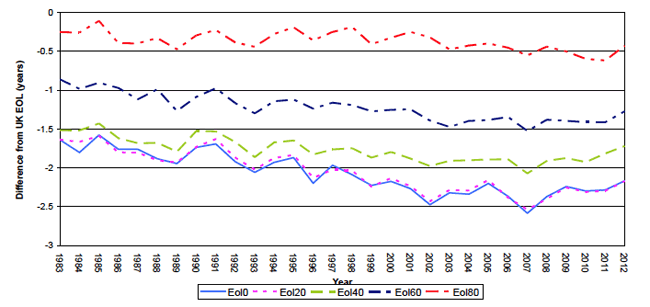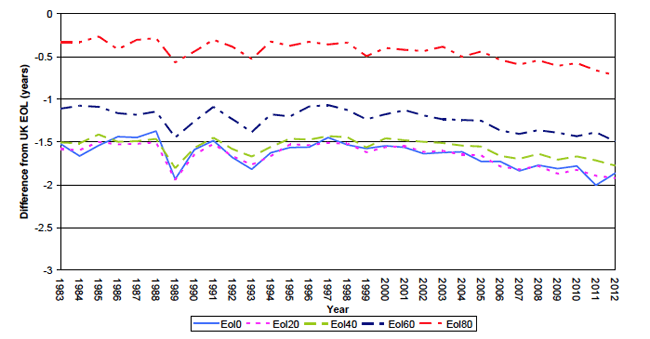
The mortality rates for the first year of the projection, mid-2012 to mid-2013, are based on the best estimates that could be made in the autumn of 2013 of the numbers of deaths at each age in 2012-13.
Assumed improvements in mortality rates after 2011-12 are based on trends in mortality rates before 2011. Improvements in mortality rates by age and gender in the base year of the projection are estimated from the trends in years from 1961 to 2012. It is assumed that annual rates of mortality improvement will converge to a common rate of 1.2 per cent per year in 2037 for most ages, and continue to improve at that constant rate thereafter. However, those born after 1922 and before 1939 have exhibited greater rates of improvement over the last 25 years than those born on either side.
A comparison of period Expectations of life (Eol) for Scotland with the UK as a whole (Figure B1) suggests there has been a gradual widening in the difference in expectations of life for males under the age of 80, since the early 1980s. There have also been increases in divergence for females since 2000 (Figure B2).
Figure B1: Period Expectations of life (Eol) for Scotland less respective expectation of life for UK - for males at birth and ages 20, 40, 60 and 80, 1983-2012

Figure B2: Period Expectations of life (Eol) for Scotland less respective expectation of life for UK - for females at birth and ages 20, 40, 60 and 80, 1983-2012

Although there have been decreases in the differentials between Scotland and the UK in 2008 and 2009, this is not sufficient evidence to suggest a change in the overall trend. Therefore, following further analysis (and as similarly done in previous sets of projections), lower rates of improvement were adopted in Scotland for males aged 27 to 59 and 66 to 95, and for females aged 28 to 41 and 65 to 92, than for the UK as a whole. At all other ages the UK levels have been used. By 2037 all improvement rates are projected to converge to the same annual rates of improvement as for the UK.
The impact of these new assumptions can be summarised using the period expectation of life at birth, based on the mortality rates for the given year. Life expectancy is assumed to rise from 75.8 years in 2009 to 81.9 years in 2037 for men, and from 80.3 years in 2009 to 85.4 years in 2037 for women.